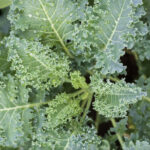 Every year, I grow a small patch of sweet basil in my herb garden.
Every year, I grow a small patch of sweet basil in my herb garden.
Growing herbs is my very modest attempt at home gardening these days, having abandoned tomatoes, peppers, eggplant, arugula and all of my other favorite Italian vegetables a long time ago. But as September approaches, I’m giving my little basil crop a grade of perhaps B-minus. My plants are smaller and shorter than usual, and their color is not as bright green as I think it should be. I am blaming the frequent torrential rainstorms that hit us this season—almost 10 inches of rain in July alone.
Nevertheless, it is time for the basil harvest at the Baer household, and my annual pesto project should still be successful. There is no substitute for pesto made on the same day the basil is picked.
I have a lot of Italian cookbooks, and almost all have a recipe for basil pesto. The formula is pretty much the same: fresh basil leaves, good Parmesan, extra virgin olive oil, garlic and pine nuts. I have often omitted the pine nuts (especially if guests have a nut allergy) or substituted walnuts (also very good). But in my experience, one recipe step is always a constant. After washing the basil leaves, make sure each leaf is thoroughly dry before proceeding. I always followed this religiously, often washing the basil early in the day to make sure no moisture remained when I was ready to cook.
Enter a new recipe and a new concept based on the award-winning pesto of Paolo Laboa, a chef from Genoa (“Genova” in Italian), Italy, and now at Solo Italiano, a restaurant in Gloucester, Mass. Chef Laboa’s pesto won the gold medal at the 2008 Genova World Pesto Championship, a competition of 100 chefs from around the world. I have tried his method, and it is indeed very good, resulting in a sauce that’s bright green, delicate (not overly garlicky) and very creamy.
But chef Laboa has exacting standards for making his pesto, which most of us can only approximate. He uses Genovese basil, which is only officially grown in Italy’s Liguria region. Chef Laboa suggests looking for Genovese-style basil either when purchasing plants or seeds. His recipe calls for Parmesan cheese that is aged 24 to 36 months and a type of pecorino called fiore sardo, a Sardinian sheep’s milk cheese. (I always just used a good Parmesan Reggiano, which I grate on my Microplane grater.) But the most startling difference in Laboa’s pesto is that he first soaks the leaves for 15 minutes in cold water to remove “bitterness” and what he describes as “unwanted licorice notes.”
And finally, chef Laboa makes his pesto in a blender, which he has first chilled in the freezer rather than the traditional mortar and pestle. Since I have a very inefficient blender from the Stone Age, I always use my food processor, which has worked pretty well. So, here is Laboa’s unique recipe for Pesto alla Genovese.
Genovese Basil Pesto
Ingredients
- 6 cups loosely packed basil leaves
- ½ cup pine nuts
- 1/3 of a small garlic clove
- ½ cup good, fruity olive oil
- 1 teaspoon sea salt
- 2/3 cup freshly grated, good, imported Parmesan cheese (use half pecorino Toscano cheese if you can find it, but not pecorino Romano, which is very salty)
Directions
- Place the glass (only glass) blender container in the freezer.
- Submerge the basil leaves in cold water and let stand for 5 minutes.
- Using your hands, gently lift leaves from the water. (Have lots of clean dishtowels nearby.) Repeat this process twice, using fresh water each time. Then rinse the bowl and soak the basil leaves for 15 minutes. (This is tedious, I know, but not hard.)
- Remove the blender container from the freezer. Combine the pine nuts and the small piece of garlic in the chilled container, cover with the olive oil and puree until the mixture is chopped and creamy. Then add the salt.
- In 4 additions, lift basil leaves from the water and shake off the water. Leave some water on the leaves to add in blending.
- Puree for 3 to 4 short pulses after each addition but do not over blend.
- Finally, add the cheese using 2 to 3 short pulses of the blender.
If you are using the pesto the same day, place it in a bowl and cover the sauce with plastic wrap, pressing it down directly on the sauce to avoid discoloration. If you are not using right away, place the pesto in a jar and cover it with a thin film of olive oil. It will keep in the fridge for three days and the freezer for three months.
Toss the pesto with a pasta of your choice but add a little of the pasta cooking water to heat the pesto and smooth it out. Don’t microwave or otherwise heat the pesto. I always add some extra grated cheese to each serving.
Making pesto at summer’s end is a culinary treat. Give this technique a try if you can. I would be interested in knowing what my Burg readers think of it.
Author: Rosemary Ruggieri Baer





